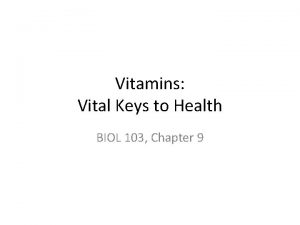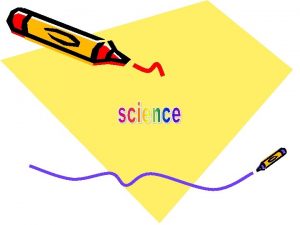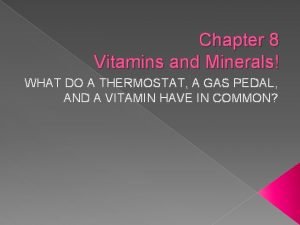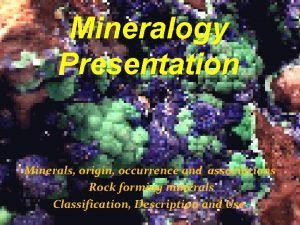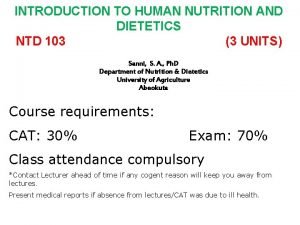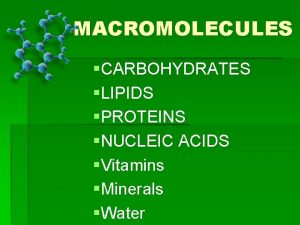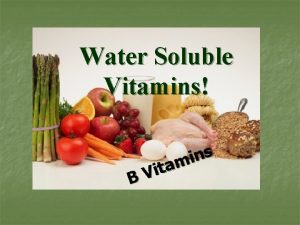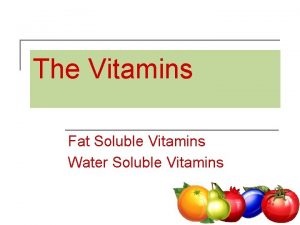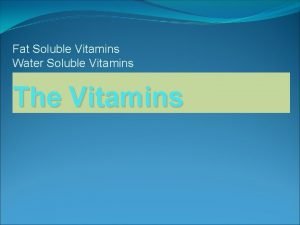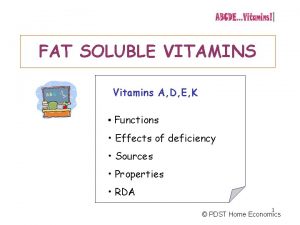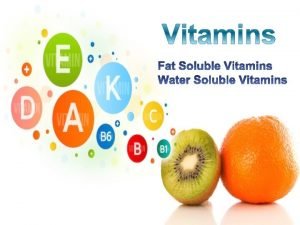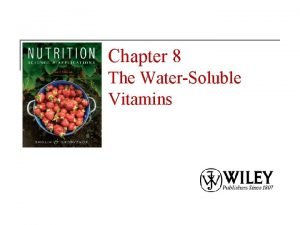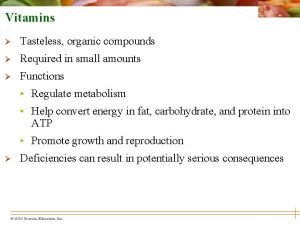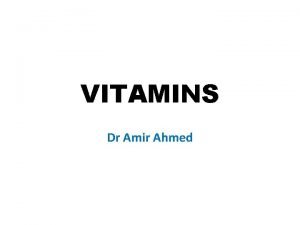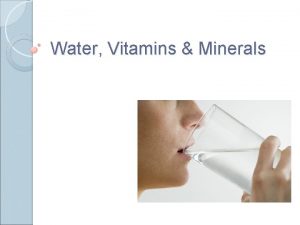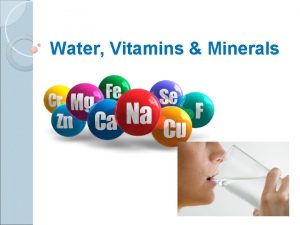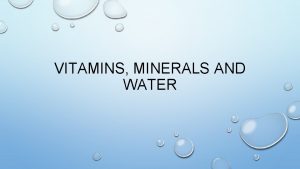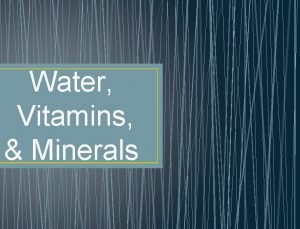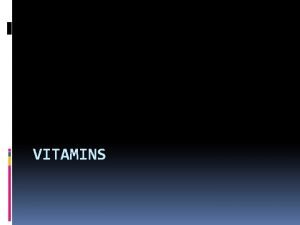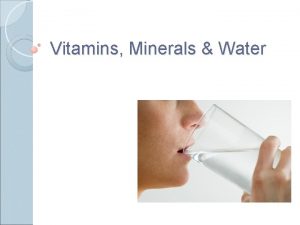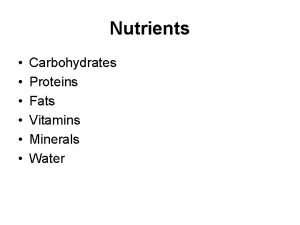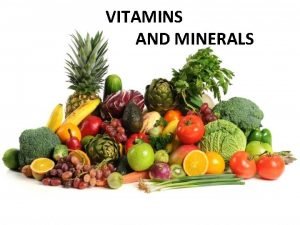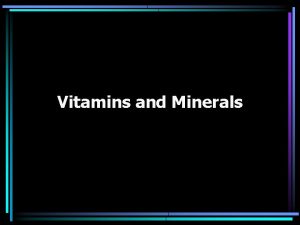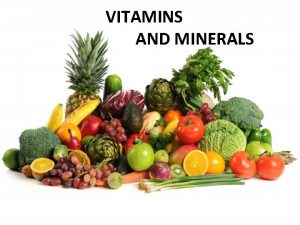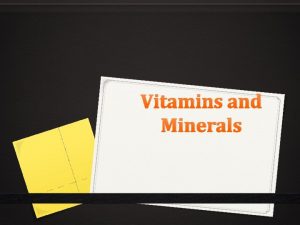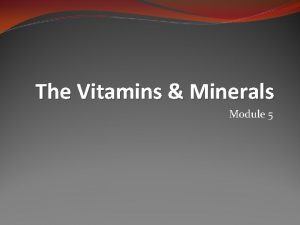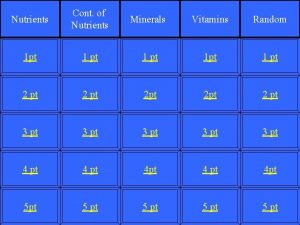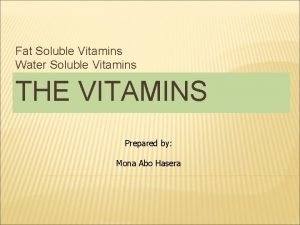Nutrients Vitamins Minerals Water Jessy G Food 10
















- Slides: 16

Nutrients --Vitamins, Minerals, Water Jessy G Food 10

water Water makes up about 60 percent of your body mass. For this reason water plays a very important role in most body functions Water provides the moist environment that is required by all living cells in the body. Water is a major component of blood and tissue fluid. It transports substances like vitamins to where they will be used. Water takes part in all the chemical reactions that occur inside and outside the body cells. Water dilutes and moistens food. Water assists in the regulation of body temperature by forming perspiration, which evaporates off the skin and cools the body.

Water dilutes waste products and toxic substances in the body. Water contributes to the formation of urine and feces, Large amounts of water are lost each day in urine and perspiration. Drinking at least eight glasses of fluids daily preferably water, is recommended Foods. especially vegetables, fruit, and milk, provide additional water sources. Liquid substances containing caffeine, such as coffee, tea, or cola drinks. should not be counted in the eight cups of fluids because they actually help to remove fluids from the body tissues.

Vitamins are chemical compounds that are essential for health. As a group they have two main functions prevention of disease and regulation of body processes. Individually. each vitamin performs cific functions in the body. Vitamins are divided into two main groups based on their solubility. Some are soluble in water and others are found in fat. Vitamins are found in a wide variety of foods. Fat-Soluble Vitamins : vitamins A, D, E, and K.


Fat-soluble vitamins means that these vitamins are found in the fat in food. They are vitamins A, D, E, and K. These vitamins are not easily lost or destroyed during the cooking of food. When your body obtains more than it can use, these vitamins are stored in the body‘s fat. Taking supplements of vitamins A D, E, and K is not recommended Excessive amounts can build up in the body because extra fat-soluble vita. mins cannot be excreted in the urine.

Vitamin A Vitamin D helps the body use calcium and helps the retina of the adjust to dim light so that it is possible to see under varying light conditions A some times known as the anti-infection vitamin because it helps you resist infections by keep- ing the lining of the mouth, nose. throat, and digestive tract healthy. It also keeps the skin healthy and promotes growth. Vitamin A is found in foods such as egg yolk. fish oils, milk and cheese. fortified margarine, and a wide assortment of dark green vegetables and deep yellow vegetables and fruit. phosphorus and is therefore needed for healthy, strong bones and teeth. Natural foods, except for fish liver oils. are poor vitamin D sources. For this reason all milk, milk products, margarine, and infant formulas sold in Canada are enriched with vitamin D. Sometimes referred to as the "sunshine vitamin, " vitamin D can be manufactured in the body by the action of the ultraviolet rays of the sun.

Vitamin E The main function of vitamin E is to prevent oxygen from destroying the polyunsaturated fats in your body. Vitamin E also helps form red blood cells and maintain the health of moist membranes. sources of vitamin E include vegetable oils, wheat germ, whole-wheat products, peanuts, and green leafy vegetables. Vitamin k Vitamin K helps normal clotting of the blood. Most people get enough vitamin K because it can be manufactured in the body by bacteria that are naturally found in the intestine. Food sources are yellow fruits and yellow and leafy green vegetables.

Water-Soluble Vitamins are not stored in large amounts in the body overdosing on water soluble vitamins is not a problem because excess quantities are excreted in the urine. Therefore, it is important that enough of these soluble vitamins are daily. complex y those of the B niacin. B 12. folacin. and others and vitamin C

Thiamin, also known as for helps the body use energy, and it allows the brain, nerves, and muscles to sources include egg yolk, legumes, nuts, whole grain bread and cereal products, and meat, especially pork and organ. Riboflavin, sometimes known as B 2, is to Niacin is important for releasing energy to help break down carbohydrates, proteins, and fats so the can use energy released from the food, Ribonavin also maintain healthy mucous membranes. These are the moist linings inside the body, for example, mouth, nasal passages, and digestive tract that allow food and body liquids to pass easily lt is important for healthy func tioning of the nervous system. Riboflavin is found in leafy green vegetables. milk and milk products, eggs, organ meats, and enriched cereals and bread products. the cells lt helps with growth and reproduction and is necessary for the normal functioning of the gastrointestinal tract and the nervous system. Niacin can be found in eggs, fish, meats, especially organ meats, peanuts. enriched and whole- grain bread products and cereals.

Folacin also helps form strong capillaries that will not bruise easily when you bump into things. they all have an important Although other B vitamins are less well known, who understand role to play Readers need to become well informed consumers food label information names of other B vitamins Here are the labels: pyridoxine often found pantothenic (vitamin B 6), vitamin B acid, biotin Vitamin C is also known as ascor red acid. It strengthens blood capillaries, forms blood cells, builds antibodies to fight infec- on. maintains connective tissue, and develops and maintains healthy bones The best sources are citrus fruit. such as oranges, grape- fruit, lemons, as well as other fresh fruit, especial- Vitamin C is very ly some berries, and green vegetables containing vitamin unstable so careful handling and preparation of food example, C is important in maintaining its vitamin C content. For when vegetables and fruit become wilted by warmth and expo- sure to air, their vitamin C content reduced. Because it is so easily dis solved in water, proper cooking methods are critical. Use a small amount water, cook quickly and eat as soon as the food is cooked linerals main functions

Minerals are a part of the body‘s tissues (4 percent of body mass) and act as a regulator of body functions. The exact role and daily requirement of many minerals are not yet known. However, the three most important minerals are phosphorus, and iron. When the recommended of these minerals are eaten in food every day, the body’s require-ment of other minerals are usually met Calcium in connection with phosphorus and vitamin D is essential for the maintenance and formation of hard bones and teeth For this reason it is essential that people of all ages receive an adequate calci um supply. Calcium is also required to maintain normal muscle tone. nerve function, and to aid in blood coagulation. The amount of calcium you need daily can be obtained by consuming a minimum of two servings of milk and milk products (at least three servings for youths or pregnant women). You also need two servings of other highquality calcium foods daily Green vegetables, such as broc coli and spinach, sardines, canned salmon with bones, baked beans, and almonds, are good sources of calcium

Phosphorus work with calcium and vitamin D to form and maintain healthy bones and teeth. It is Iron is essential for the formation of hemoglobin in the red blood cells. Iron enables the blood to also very important in energy metabolism cause calcium and phosphorus are found together almost always, the importance of phosphorus as an essential nutrint is often overlooked. When there is sufficient calcium in your die there is likely to be enough phosphorus in the diet as well. Unless you consume milk products or some animal proteins, it will difficult for you to get the phosphorus you need。 transport oxygen and carbon dioxide throughout the body. When there is insufficient iron the size o red blood cells is reduced and therefore the amount of oxygen carried by the blood is less. Iron is present in many forms in food. It is found in liver, kidney, red meat, egg yolk, some shellfish, whole-grain products dried legumes, and green vegetables, such as broccoli, Brussels sprouts, beans, asparagus, and beet greens. The iron in animal products, such as meat and seafood, is absorbed more efficiently by the body than the iron in plants, such as spinach. Iron from plants i absorbed more fully when eaten with a vitamin rich food. Careful shoppers need to look for words such as “ferrous” or reduced iron“ on labels, which means that the iron is absorbed more easily by the body than in other forms. The importance of zinc has been recognized more recently zinc is involved in protein building and is associated with the hormone. insulin. It has been found to play a role in wound healing. Sources egg yolks, seafood, and whole grains ongoing research has demonstrated the importance of trace elements They are found in very small amounts in foods. Therefore, it is very important to eat a wide variety of foods balanced from the four Because processing removes some valuable nutrients, it is recommended that unprocessed foods form the major part of your meals


Iron is essential for the formation of hemoglobin in the red blood cells. Iron enables the blood to transport oxygen and carbon dioxide throughout the body. When there is insufficient iron the size o red blood cells is reduced and therefore the amount of oxygen carried by the blood is less. Iron is present in many forms in food. It is found in liver, kidney, red meat, egg yolk, some shellfish, whole-grain products dried legumes, and green vegetables, such as broccoli, Brussels sprouts, beans, asparagus, and beet greens. The iron in animal products, such as meat and seafood, is absorbed more efficiently by the body than the iron in plants, such as spinach. Iron from plants i absorbed more fully when eaten with a vitamin rich food. Careful shoppers need to look for words such as “ferrous” or reduced iron“ on labels, which means that the iron is absorbed more easily by the body than in other forms.

That all Thank you
 Water soluble vitamins vs fat soluble vitamins
Water soluble vitamins vs fat soluble vitamins Food pyramid carbohydrates fats proteins vitamins minerals
Food pyramid carbohydrates fats proteins vitamins minerals Chapter 8 vitamins and minerals
Chapter 8 vitamins and minerals Classify minerals
Classify minerals Vitamin flowchart
Vitamin flowchart Are vitamins and minerals macromolecules
Are vitamins and minerals macromolecules Doelgroepvermindering jongeren
Doelgroepvermindering jongeren Jessy gonzalez
Jessy gonzalez Water and water and water water
Water and water and water water Water soluble vitamins characteristics
Water soluble vitamins characteristics Vitamins and their other names
Vitamins and their other names Water soluble vitamins characteristics
Water soluble vitamins characteristics Adek vitamins fat soluble
Adek vitamins fat soluble Water soluble vitamins characteristics
Water soluble vitamins characteristics Water soluble vitamins
Water soluble vitamins Water soluble vitamin absorption
Water soluble vitamin absorption Vitamin d ergocalciferol
Vitamin d ergocalciferol
